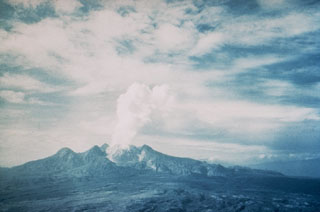Report on Lamington (Papua New Guinea) — November 1991
Bulletin of the Global Volcanism Network, vol. 16, no. 11 (November 1991)
Managing Editor: Lindsay McClelland.
Lamington (Papua New Guinea) Long-term decline in thermal activity
Please cite this report as:
Global Volcanism Program, 1991. Report on Lamington (Papua New Guinea) (McClelland, L., ed.). Bulletin of the Global Volcanism Network, 16:11. Smithsonian Institution. https://doi.org/10.5479/si.GVP.BGVN199111-253010
Lamington
Papua New Guinea
8.95°S, 148.15°E; summit elev. 1680 m
All times are local (unless otherwise noted)
"A brief aerial and ground inspection was carried out at the summit on 12 October. Most of the 1951 summit crater dome had a dense canopy of vegetation, broken only by a number of thermal areas scattered around the summit. Weak vapour emission was noted from fumaroles. Temperatures were measured in one of the larger thermal areas; the highest reading was 93°C. In 1973, the highest temperature recorded in the same thermal area was 362°C. This temperature decrease is consistent with the visual impression of declining activity. Seismic surveillance from a station near the summit was suspended in 1989; measurements in November revealed no volcanic seismicity."
Geological Summary. Lamington is an andesitic stratovolcano with a 1.3-km-wide breached summit crater containing a lava dome that rises above the coastal plain of the Papuan Peninsula of New Guinea north of the Owen Stanley Range. A summit complex of lava domes and crater remnants tops a low-angle base of volcaniclastic deposits dissected by radial valleys. A prominent broad "avalanche valley" extends northward from the breached crater. Ash layers from two early Holocene eruptions have been identified. In 1951 a powerful explosive eruption produced pyroclastic flows and surges that swept all sides of the volcano, killing nearly 3,000 people. The eruption concluded with growth of a 560-m-high lava dome in the summit crater.
Information Contacts: B. Talai and C. McKee, RVO.

